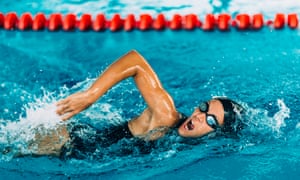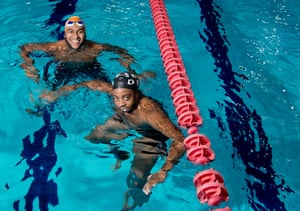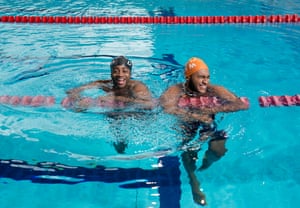There’s a lot to love about swimming – but churning up and down on your own can be monotonous. That’s why Peigh and I started the Swim Dem Crew, a group of swimmers who meet at the pool for training every week and social swims followed by breakfast together at the weekend. We’ve grown in the last two years and now go on trips to races such as the Dart 10k. It was the first time that any of us had embarked on that kind of distance, and one of the highlights of the year.
Many people don’t realise swimming is a full-body exercise. It can be exhausting, but so rewarding. To pick it up again, start with at least one lesson with a coach (it’s easy to find adult lessons; check swimming.org for your nearest pool). It’s likely you haven’t been taught how to do front crawl since school – if you ever had formal lessons at all. Having someone look at your form in the water can transform the way you move. Some pools will let a coach or friend film you swimming. Just like when people hear their voice on a recording and say, “That’s what I sound like?”, you’ll be surprised at how you look when you swim.
Give yourself a challenge to get started. After university I began to swim again after a long break, and needed a rest after just 50m. I decided to swim for 20 minutes every day for a month and it helped me get fit as the distance I covered in that time slowly increased. At Swim Dem, we test ourselves each month: how many lengths can we do in 20 minutes? The aim is to do 20 lengths in under 20 minutes. Peigh, who only taught himself to swim two summers ago, can now do 20 in 20, and I’m on 20 in 17. A bit of competition works wonders for your motivation.

How to do… front crawl
Get your face in the water
The basic body rule for front crawl is face down, legs up. If you don’t get your face in the water, your legs will struggle to rise to the surface, making it harder to move. Think of the body like a seesaw: lifting your head up makes your legs go down and vice versa. Practise putting your face in the water and blowing out of your nose while keeping your mouth closed. The more comfortable you are with this, the easier it will be to maintain a good position.
Use your whole legs to kick
The two key things: kick from the hips, not the knees (think about long kicking motions using your whole leg), and keep your ankles relaxed. This allows your feet to flick the water away, helping to propel you forward. Your kicking motion should be smooth, alternating each leg; your feet can break the surface but not come fully out. A little splash is fine; a slapping sound is not.
Keep your elbow high
As your hand enters the water, keep your fingers closed together, with an open palm. Press your hand into the water in front of you; as you pull your arm back under your body, think about pushing the water with your hand, keeping that open palm facing behind you. Make sure your arm goes all the way back. Then raise your elbow high out of the water, so it brings your hand out, too. Put your hand forward and repeat. Your arms are alternating: when one hand is in front of you, the other should be all the way behind you.
Breathe on both sides
As your elbow comes out of the water, turn your head gently to one side to take a breath. Your ear should remain in the water. Breathe in. Keep kicking your legs, and as you twist your head back into the water, exhale fully and continue your arm movement. Practise breathing on both sides for balance and to prevent neck ache.

How to do… breaststroke
Scoop the water
Your arms start in front of you; keep fingers closed. Twist your palms to face out and pull them back so your elbows are out and your hands at 10 and 2 on a clock. Pull them towards you, making sure you feel them really scooping that water. Elbows still bent, your hands should be close to your chest. Bring them together like a prayer hand, with fingertips forward; push forward with your hands together as one. Repeat.
Flex your feet
In front crawl or backstroke, feet are pointy like a ballerina; in breaststoke they need to flex out, with toes up. Start with legs extended (and toes pointed). Bring heels to bottom, bending your knees. Now keep heels together while your toes are flexed apart. Then kick both out to the side, kicking away from each other in a near circle before coming together again, feet pointed. The feet are key; if you don’t flex them when your heels are together, you won’t go anywhere. Practise on your back, holding a float. But watch out that you don’t bring your knees up to your chest, instead of your heels to your bottom.
Remember to breathe
Just before your hands touch, you should notice your torso lifting out of the water. Take a breath, then with hands in prayer position, put your face in the water, push hands out in front of you and breathe out fully. Two tips: put your face in, rather than your whole head; come up enough to breathe, but don’t jerk your whole head out.
Use the glide
When you kick your legs out, you get the reward of all that effort. Don’t waste it. Hold the position of extended legs for two or three seconds – that’s the glide, where you should move around 1.5m. If you kick again too soon, you will jerk forward, then backwards. Think of it as kick, gliiiide, kick, gliiiide.

How to do… backstroke
Relax
The key to a great backstroke is letting go of any fear you may have of the water. If you’re uncomfortable with lying on your back in the pool, then hold on to the side with one hand, bend your knees so that your shoulders are in the water, look up, stick one leg out, then both legs, and get your ears in the water. Keep on practising this until you feel comfortable enough to stretch out your legs and one arm, and then finally let go.
Learn how to kick
To really move in the water, the most important thing to master is the kick – that’s what will stop you flailing around the pool. Start by floating on your back, then flap your hands at your sides with your palms open and fingers closed, as if you are fanning your legs. This will give you some propulsion and allow you to focus on your kick. As with front crawl, keep your ankles relaxed and kick from the hips; up and down, up and down. Keep your legs close together and your knees slightly bent as you kick down. Away you go.
Make those arms move
Start with both arms down by your side and keep them straight. Bring one straight arm out of the water, brush it against your ear (this will help your shoulders rotate) and twist your hand around so that the little finger touches the water first (with your palm away from you), then bring the hand back down to your side. Repeat the same action with your other arm. Now make it a fluid, faster movement; when your first hand goes into the water and begins to pull down, raise the other arm up out of the water. Keep the arms moving continuously, circling around your body.

Push yourself in the pool: the swimming workout
Designed for a keen swimmer in a 25m pool, this is a great way to break up a session, keep things interesting and work hard, giving you a total swim of 2,500m. If that seems too far, halve the distances; if you fancy yourself as an elite swimmer, multiply by two! Take the suggested 30 seconds rest between each activity. You’ll thank us for it near the end.
Warm up
Gentle pace
Change from backstroke to front crawl after each length. The pace should be gentle and relaxed; you’re simply going through the motions, to get blood pumping around the body, loosen joints and warm muscles.
500m
30 seconds rest
Main set
Slow to normal pace
Start off at your warm-up pace and gradually increase the speed after each length until your arms and legs are ticking along at your usual average pace for the last length.
150m
30 seconds rest
Normal pace
“Normal” is your own average pace: a speed you can maintain for a long time without getting too tired. You’re leaving plenty in the tank while pushing at the same time.
150m
30 seconds rest
200m
30 seconds rest
250m
30 seconds rest
300m
30 seconds rest
High effort – 75% of maximum exertion
Now it’s time to ramp up your effort. Did you know that you can sweat in the water? You’re about to find out how that feels. Use about 75% of what you’ve got. Your legs should kick faster and your arms will pull the water more quickly.
250m
30 seconds rest
200m
30 seconds rest
150m
30 seconds rest
Big push – 90% of maximum exertion
This pace is one of the trickiest to pull off, in and out of the pool. You’re one step away from giving it your absolute all. Aim for six kicks for each arm pull but keep in mind you still have to swim after this. Push it hard and leave something in the legs for the last hurrah.
100m
30 seconds rest
All out – maximum, 100% exertion
Now it’s time to unleash your inner Michael Phelps, Cullen Jones, Katie Ledecky or Simone Manuel. Show everyone in the pool what you’re made of. Be strong, be quick and be smart. Maintain a 100% all-out effort for 50m and bask in the glory of completing a Swim Dem Crew sprint.
50m
2 minutes rest
Warm down
Gentle pace
Once you’ve caught your breath, it’s time to warm down. Use a slow front crawl to reduce your heart rate. Keep the pace nice and easy; you’ve earned it.
200m

